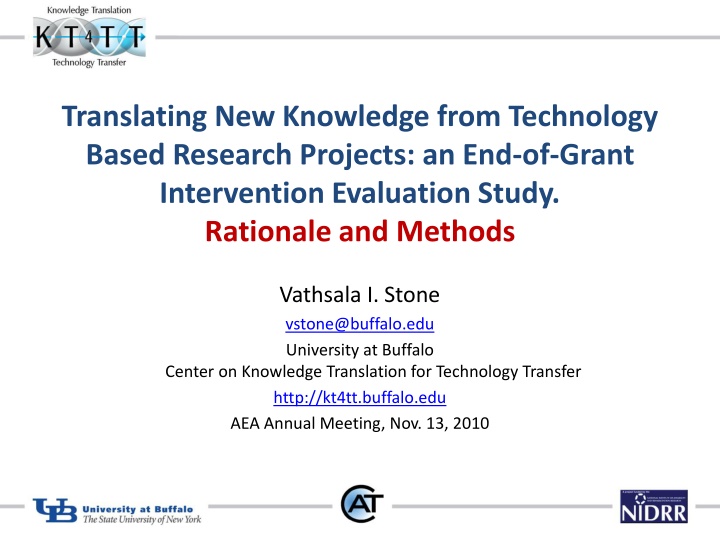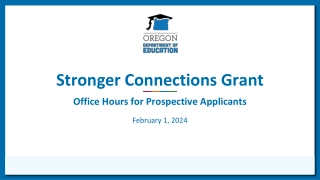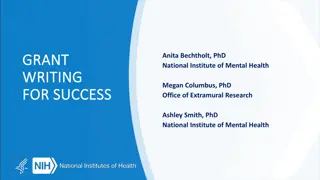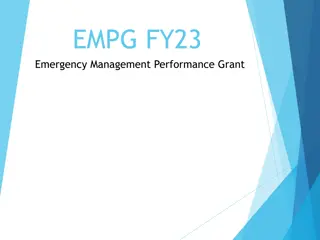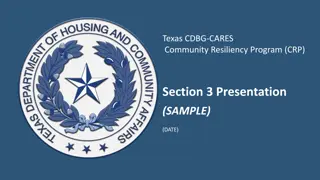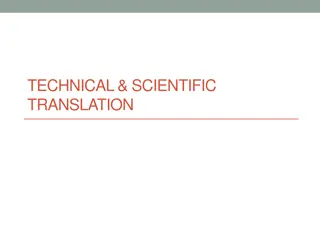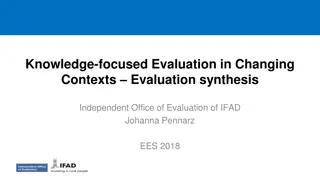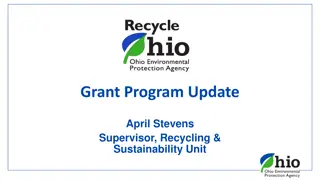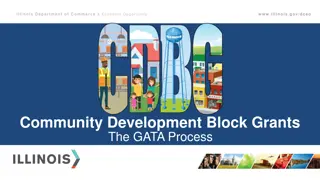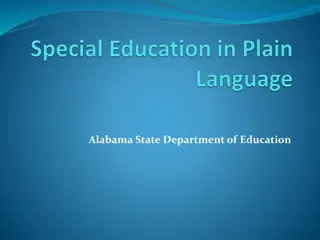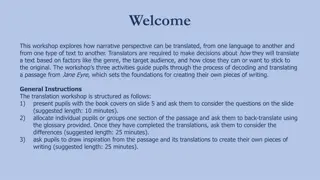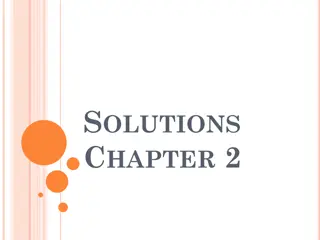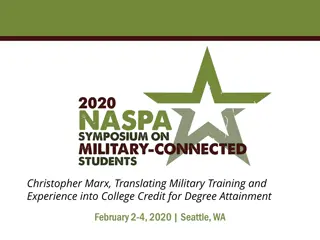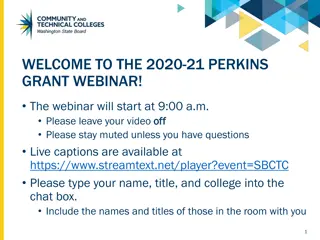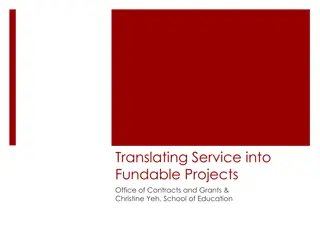End-of-Grant Intervention Evaluation Study: Translating New Knowledge from Technology-Based Research Projects
This study focuses on developing best practice models for Knowledge Translation (KT) in technology-based research projects, aiming to enhance the impact of R&D investments. It explores effective strategies to increase knowledge application by intermediary and beneficiary stakeholders, particularly in the field of Augmentative and Alternative Communication (AAC).
Download Presentation

Please find below an Image/Link to download the presentation.
The content on the website is provided AS IS for your information and personal use only. It may not be sold, licensed, or shared on other websites without obtaining consent from the author.If you encounter any issues during the download, it is possible that the publisher has removed the file from their server.
You are allowed to download the files provided on this website for personal or commercial use, subject to the condition that they are used lawfully. All files are the property of their respective owners.
The content on the website is provided AS IS for your information and personal use only. It may not be sold, licensed, or shared on other websites without obtaining consent from the author.
E N D
Presentation Transcript
Translating New Knowledge from Technology Based Research Projects: an End-of-Grant Intervention Evaluation Study. Rationale and Methods Vathsala I. Stone vstone@buffalo.edu University at Buffalo Center on Knowledge Translation for Technology Transfer http://kt4tt.buffalo.edu AEA Annual Meeting, Nov. 13, 2010
Background: Knowledge Translation [KT] Emergent field Research Utilization - influence public policy (Weiss, 1979) Healthcare (CIHR, 2004; 2005; 2009) Evidence practice impact on beneficiaries Impact from funded Research [R&D] (Wholey et al, 2004)
Knowledge Translation for Technology Transfer (KT4TT) Technology based R&D K (Output) TT Market (Outcome) Benefit users (Impact) Creation & Strategic Communication of K Through relevant Stakeholders For Products and Services in market (TT) To benefit end users Examples: New wheelchair cushion, easier household appliances.
Background: Study Context Funding agency: National Institute for Disability and Rehabilitation Research (NIDRR) Beneficiaries: Persons with Disabilities Knowledge Producers: NIDRR s Technology grantees (R&D projects) Knowledge Users: (6 stakeholder groups) Manufacturers; Clinicians; Transition Brokers; Researchers; Policy makers; Consumers with disabilities
Knowledge Translation [KT] Interventions Problem: Sub-optimal level of demonstrated impact from R&D investment. Challenge: Develop an effective KT intervention strategy to increase impact. What will enhance K use (application) by intermediary and beneficiary stakeholders? Knowledge to Action Model - Graham et al, 2006 Formats of communication? Channels of delivery? What else? Why?
Study Purpose Overall Purpose: Develop KT best practice models for (later use by) K producers (technology grantees) Research Project: Conceptualize a KT intervention strategy for a selected K; implement and evaluate effects on relevant Users. 3 technology areas; first study on Augmentative and Alternative Communication (AAC)
Intervention Study: Procedures Objective: Evaluate effectiveness of KT strategy for a given new K in AAC field; demonstrate what works for NIDRR and grantees (K producers). Focus: End-of-Grant KT ( completed grantee project) Approach: Select an Innovation (grantee research study) Translate the study implement intervention on six K user populations measure effects: Awareness, Interest and Use of New Knowledge (AIUNK).
Evaluation Quality Target stakeholder: NIDRR & Technology Grantees Utility: Effective KT strategy for use by grantee; specific feedback from K users for strategy refinement. Feasibility KT strategy conceptualized from grantee perspective, & replicated for different technology outputs. Accuracy RCT design (merit) + follow up (worth). Propriety involve K producer (grantee) in translation.
Study Procedures (contd.) Basic guide: KTA action cycle steps 1. Create Intervention Strategy & tools 2. Implement and evaluate Intervention
Evaluation Quality (Contd.) Evaluating knowledge (K) for translation: Is the K credible? Merit (rigor) of evidence Is the K worthy? (Relevance to K users ) Both are important
Create Intervention 1. Grantee Innovation Profile (GIP) for Output [Innovation = Novel, Feasible & Useful] 2. Knowledge Value Maps (KVM) (Rogers, 2000) [User Context & needs of organizations] 3. Tools: Six Contextualized Knowledge Packages Six Webinars (training) Technical Assistance upon request
Implement Intervention: Design Design: Randomized Control Trial (RCT) 3 groups : KT (proposed strategy), KDU (traditional dissemination) and Control Pre Int. Post 1 Int. Post 2 Duration: 8 Months Sample: 270 = 45 subjects x 6 stake h. groups (Recruited through national organizations).
Implement Intervention: Measures Measure: Awareness, Interest and Use of New Knowledge Focus: Instrumental Use (Estabrooks, 1999) Instrument: AIUNK (based on Halls et al, 2006); Web-based survey Items cover 6 categories within 10 levels.
Project Status Baseline data collected for Current Study in AAC Expected completion June 2011 Planning next Replication Studies using the KTA action cycle (model validation)
Acknowledgement This is a presentation of the KT4TT Center which is funded by the National Institute on Disability and Rehabilitation Research of the U.S. Department of Education, under grant number H133E030025. The opinions contained in this presentation are those of the grantee and do not necessarily reflect those of the U.S. Department of Education.
Thank you!! Contact: vstone@buffalo.edu http://kt4tt.buffalo.edu Questions?
Fig. (i). Implementing the AAC KT Intervention Study via KTA model
Fig.(ii). Research Design for the KT Intervention Study. Baseline Assessment Intervention Delivery Post Test 1 Intervention Delivery Post Test 2 R T1 O (1 6) X1 O (1 6) X1 O (1 6) R T2 O (1 6) X2 O (1 6) O (1 6) R C O (1 6) O (1 6) O (1 6)
Fig. (iii). AIUNK Survey Framework (Based on Halls et al, 2006) CATEGORIES Being Aware Getting Information Sharing Assessing Planning Implementing 0 - NON-AWARENESS 1- AWARENESS: 2 ORIENTATION: 3 PREPARATION: 4 - INITIAL USE: LEVELS 5 - ROUTINE USE: 6 EXPANSION: 7 COLLABORATION: 8 INTEGRATION: 9 MODIFICATION:
Fig. (iv). A KT Framework for Technology Based Innovations Need to Knowledge (NtK) Model (Lane and Flagg, 2010) http://kt4tt.buffalo.edu/knowledgebase/model.php Need & Envisioned Solution Impact on Beneficiary R D P KtA KtA KtA 3 processes; 3 states of K; 3 outputs Introduces Prior-to-grant KT
Key References 1. CIHR. About knowledge translation. Retrieved October 25, 2009, from http://www.cihr- irsc.gc.ca/e/29418.html 2. Graham, I.D., Logan, J., Harrison, M.B., Straus, S.E., Tetroe, J., Caswell, W., & Robinson, N. (2006). Lost in translation: time for a map? The Journal of Continuing Education in the Health Professions, 26(1), 13-24. 3. Hall, G.E., Dirksen, D.J., and George, A.A. (2006). Measuring Implementation in Schools: Levels of Use. Austin, TX: Southwest Educational Development Laboratory (SEDL). 4. Lane, J.P. & Flagg, J.L. (2010). Translating three states of knowledge: Discovery, invention & innovation. Implementation Science. http://www.implementationscience.com/content/5/1/9 5. Rogers, J.D. (2000). Theoretical consideration of collaboration in scientific research. In J.S. Hauger and C.McEnaney (Eds.), Strategies for competitiveness in Academic Research (Chapter 6). 6. Sudsawad, P 2007. Knowledge Translation: Introduction to Models, Strategies, and Measures. Austin: Southwest Educational Development Laboratory, National Center for the Dissemination of Disability Research. (p.4; 21-22) 7. Wholey J S., Hatry H P., and Newcomer, K E (eds.) (2004). Handbook of Practical Program Evaluation, San Francisco: Jossey-Bass.
